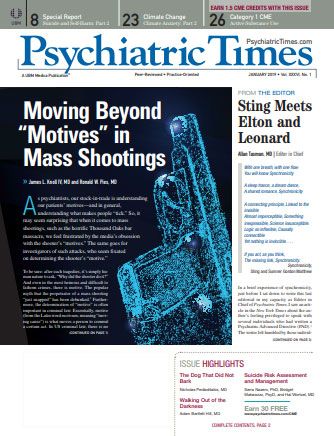Publication
Article
Psychiatric Times
Suicide Risk Assessment and Management: Tips for Improving Care and Outcomes
Author(s):
Determining how to ensure delivery of excellent care while balancing medicolegal demands may seem to be an impossible task. When done in a collaborative way, safety planning can help the clinician better understand risk and targets for intervention.

CASE VIGNETTE
It is late Friday afternoon and you are about to see your last patient, Mr G. This morning, as you prepared for your third meeting with him, you jotted down notes about the need to review the benefits and potential side effects related to his new psychiatric medications and a reminder to check back in on the psychosocial stressors that seemed to be escalating for your patient when you saw him a few weeks ago. These stressors, in combination with chronic depression and anxiety, served as the catalysts to why he had come in to see you for the first time 2 months earlier. When you meet Mr G, you notice that his affect is more dysphoric than his previous presentations, with notable agitation and hopelessness that permeates the rest of your time together. He discloses that things have not gotten better and that he is starting to give up hope that things will ever get better. His marriage is “failing,” he might be laid off from work soon, and is feeling like a burden to others more and more each day.
Despite being a seasoned clinician, you feel a twinge of anxiety as you take in his comments. Your mind is moving quickly, and you know you need to get a suicide risk assessment under way. That natural anxiety does not dissipate. In fact, it becomes more intense when you gather the “results” of your suicide risk assessment.
The data confirm that your patient is positive for many suicide risk factors (eg, demographics, psychiatric diagnoses, chronic suicidal ideation, hopelessness, burdensomeness) and is clearly experiencing several psychosocial stressors that are exacerbating his clinical presentation and contributing to several warning signs (eg, isolation, trouble sleeping, agitation). He also discloses that his suicidal ideation has become more severe and frequent, that he has been thinking more about the plan for suicide he has always had in the back of his mind (overdosing via a highly lethal combination of medications to which he has access), and indicates intent for suicide as 3 out of 10 (0 = no intent; 10 = highest intent).
Although the patient’s current warning signs and suicide risk indicators (ie, ideation, intent, plan, access to means) suggest elevated risk, he is also openly disclosing and seeking support, all good signs. But you cannot ignore that his combination of historical/baseline factors suggests elevated risk for suicide. Your lack of a lengthy therapeutic relationship also complicates the suicide risk formulation. Weighing all of these factors, you eventually arrive at the decision that “moderate risk for suicide” is the best formulation but feel stuck about the optimal way to proceed.
Predicting risk for suicide
When thinking about a case like this, determining how to ensure delivery of excellent care while balancing medicolegal demands may seem to be an impossible task. Recent increased attention to the alarming public health problem of suicide has led to greater discourse and new implementation strategies to prevent suicide. There remains an intimidating gap in empiric knowledge on how to determine, with any certainty above chance, who will die by suicide among those exhibiting risk. This dilemma-the impetus to eliminate suicides and a lack of clearly defined paths for how to arrive at that goal-naturally causes apprehension.
In fact, this issue has caused some suicide researchers to publish their reexaminations of what we know and do not know-an important contribution toward progress in the field. Such publications, however, have translated to clinical confusion. For example, research suggesting that suicide risk assessments are unable to predict who will die by suicide have led to provocative dialogues on whether these approaches should be abandoned, especially given the implied goal that our risk assessment approaches are meant to be predominantly geared toward prediction.1 The predicament of a goal to eradicate suicide along with unrealized ability to accurately predict suicides have cast doubt on the fact that suicide risk assessment and management are actually critical to improving the very care and outcomes current suicide prevention approaches are striving to achieve.2
Of course, along with many clinicians, suicide loss survivors, and those with lived experiences, we are invested in finding the answers to prediction. We argue, however, that until that time arrives, and even when it does, we should incorporate assessment and management approaches that are in and of themselves opportunities to collaboratively work with our patients to help them weather suicidal crises and ultimately create a life worth living.3
Risk assessment
Our therapeutic risk management of the suicidal patient (TRMSP) model is structured to achieve these goals. The TRMSP framework is built on and integrates the tenets of prior research and clinical evidence, the ethical principles of autonomy, nonmaleficence, and beneficence, and medicolegal knowledge and awareness. TRMSP consists of three core components: a clinical interview/suicide risk assessment that is augmented by an evidence-based structured instrument, stratification of risk by severity and temporality, and a collaboratively developed safety plan. In his discussion of the TRMSP model, Silverman4 states that it “provides a way forward and a very nice roadmap not only for better determining level of risk but also for identifying appropriate strategies for intervention and management.”
Every clinician should execute a suicide risk assessment when working with patients who are either at risk for suicide or exhibit warning signs. Listing all the elements to a suicide risk assessment is outside the scope of this article, but the goal behind any risk assessment is analogous to that of an inductive process, that being to gather data about suicide risk indicators, risk and protective factors, and functional patterns to ultimately inform management and intervention approaches in a highly individualized fashion. It is worth stating that the risk assessment is best viewed as an ongoing process, as opposed to an event. Given that the risk assessment process evolves over time, and that there is a potentially endless stream of pertinent and dynamic data to gather, the notion of a complete assessment at any given point in care is rather elusive.
Nonetheless, there are core components that should not be omitted. The addition of a reliable and valid structured instrument to this process is not only medicolegally sound but also affords the opportunity to yield additional information that may be missed during a traditional free-form clinical interview. A more in-depth discussion of considerations when selecting an instrument is provided in Homaifar et al.5 Selecting an instrument that attends to critical content, or an element of your clinical interview that is not as robust (eg, protective factors), and enables a quantitative element to your data can be especially helpful. This can enhance disclosure and dialogue between the clinician and patient, which may ultimately shape and guide outcome tracking across management and intervention approaches.
For example, a quantitative measure that helps identify reasons for living (eg, the Reasons for Living Inventory6) can be used therapeutically to first help Mr G identify that he does in fact have reasons to keep going and then later to track improvement in this area over time. Similarly, utilizing a measure reflecting the intensity of ideation, intent, and/or desire to die by suicide helps other clinicians (eg, an on-call provider unfamiliar with the patient) recognize changes from the individual’s baseline. Such data help other providers distinguish between modest changes around a chronic baseline versus significant escalations that potentially warrant life-saving interventions, thus facilitating patient-centered, individualized care across both time and clinicians.
Risk stratification
As highlighted in the example, clinicians often grapple with the suicide risk formulation for patients similar to Mr. G, that is, those who are chronically suicidal and/or because of demographic and historical factors carry evidence that suggests heightened risk. Forced to choose between commonly used terms such as mild/low, moderate/intermediate, and high, clinicians often experience needless dilemmas. The clinician might worry about documenting high risk and having to explain the decision to not seek involuntary hospitalization. Alternatively, the clinician might feel that the present risk is sufficiently low to not warrant admission, documents low risk, but then worries about having to explain the low-risk designation if an unanticipated suicide attempt occurs. By solely concentrating on severity for these types of patients, a prudent clinician will often land on a formulation of “moderate risk for suicide” given the practicality of all competing factors. This splitting-the-difference approach, however, tends to offer a less nuanced formulation in relation to the nature of the patient’s risk and seldom clearly suggests what needs to be done to mitigate risk in the present and moving forward.
The TRMSP framework provides an alternate approach to the risk formulation by using a stratification across both severity and temporality. This allows for a more nuanced discussion of risk by enabling a clinician to simultaneously speak to chronic factors (ie, demographic risk factors, past suicide attempts, diagnoses) as well as acute presentation (ie, indicators of risk like preparatory behaviors, intent).
In Mr G’s case, we might decide that he is at high chronic risk and intermediate acute risk for suicide. If we were to slightly change the details of his presentation, to instead reflect that he was experiencing suicidal ideation with some greater frequency, but had an intent of 0, no preparatory behaviors, and no suicide plans, we might then indicate low acute risk for suicide. The critical addition of stratification by temporality allows the clinician to more effectively determine and document what is the best management approach given both acute and chronic considerations. This is the goal of the stratification, ensuring the right management approach, not predicting what will or will not happen in days, weeks, months, or years ahead. Thus, each severity level of acute and chronic risk has associated management considerations. Importantly, decisions surrounding management approaches can be collaborative.
For example, a voluntary psychiatric admission or intensive outpatient management could be appropriate for Mr G. If we know that he had a previous psychiatric admission 5 years ago that was not helpful, and that an admission at this time would complicate his financial and family factors, we might collaboratively discuss a management plan that supports the therapeutic alliance and the opportunity to mitigate risk in an ongoing fashion. Further discussion of risk stratification can be found in Wortzel et al.7 We also encourage readers to visit the risk stratification tool we developed at https://www.mirecc.va.gov/visn19/trm/#tool.
Safety planning
A major component of suicide risk management is safety planning. Before briefly outlining our approach to safety planning, it is critical to note the many pitfalls of the management approach of “no suicide contracts.” These types of contracts, which essentially involve the patient making a commitment to not die by suicide until the next session or that he or she will not enact suicidal behavior without first contacting the clinician, have no evidence base behind their efficacy, afford no medicolegal protection, are not patient-centered, and can have paradoxical effects for both the patient (eg, less disclosure about suicidal desire to not disappoint the clinician) and the clinician (eg, false sense of security which leads to less engagement in appropriate management approaches). In contrast, the safety planning process involves a hierarchical set of strategies designed to help a patient know how to identify and how to cope when in a suicidal crisis.
Especially when done in a collaborative way, safety planning can help the clinician better understand risk and targets for intervention (eg, that the patient is unable to identify warning signs and has limited coping skills) while also providing information about what types of management approaches may be indicated. So, for Mr G, if he is able to develop a sound safety plan that involves many coping strategies and avenues for help, is willing to use the plan over the weekend, and is open to sharing his plan with his wife, intensive outpatient management becomes much more feasible. In contrast, if he is unable to identify how and when his symptoms and distress get worse, has no confidence that he would use coping strategies this weekend, and is unwilling to reach out for professional help if his suicidal intent increased, you would likely need to reconsider how to bolster management approaches as this patient may not be able to independently maintain safety between today’s session and Monday’s check-in call. For a greater discussion on safety planning please see Matarazzo et al.8
Conclusion
Armed with a framework that can optimize the therapeutic benefit of risk assessment, we strongly believe that the real goal of our practice, which is to take care of our patients, can be achieved regardless of the current state of the field. TRMSP is a framework that we have found to be easy to implement, which can ultimately increase the clinician’s comfort and confidence while allowing engagement in work that can be incredibly challenging.3 The three small additions of using reliable and valid structured instruments to augment a suicide risk assessment, enhancing suicide risk formulation by stratifying risk across severity and temporality, and collaboratively developing a safety plan, are essential ingredients to improving care and guiding the path to optimizing outcomes. Finally, while we must recognize the persisting limitations of current risk assessment techniques in relation to prediction of suicide, we must not forget that these same procedures can, and sometimes do, afford life-saving opportunities.
LEARN MORE We encourage readers to visit the risk stratification tool at https://www.mirecc.va.gov/visn19/trm/#tool
Disclaimer: The views and opinions expressed in this article are those of the authors and do not necessarily reflect the official policy or position of any agency of the US government, agency of the State of Colorado, academic institution, or the institutions and organizations to which the authors are affiliated.
Disclosures:
Dr Nazem is Clinical Research Psychologist, Rocky Mountain Regional VA Medical Center, Rocky Mountain Mental Illness Research, Education and Clinical Center (MIRECC), and Assistant Professor, University of Colorado School of Medicine, Departments of Psychiatry and Physical Medicine and Rehabilitation, Aurora, CO; Dr Matarazzo is Director of Clinical Services, Rocky Mountain Regional VA Medical Center, Rocky Mountain MIRECC, and Associate Professor, University of Colorado School of Medicine, Department of Psychiatry, Aurora, CO; Dr Wortzel is Director of Neuropsychiatric Services, Rocky Mountain Regional VA Medical Center, Rocky Mountain MIRECC, Michael K. Cooper Professor of Neurocognitive Disease, Director of Neuropsychiatry, and Associate Professor, University of Colorado School of Medicine, Departments of Psychiatry, Neurology, and Physical Medicine and Rehabilitation, Aurora, CO.
The authors report no conflicts of interest concerning the subject matter of this article.
References:
1. Murry D, Devitt P. Suicide risk assessment doesn’t work. Scientific American. March 28, 2017. https://www.scientificamerican.com/article/suicide-risk-assessment-doesnt-work/. Accessed November 6, 2018.
2. Wortzel HS, Nazem S, Bahraini BH, Matarazzo BB. Why suicide risk assessment still matters. J Psychiatr Pract. 2017;23:436-440.
3. Nazem S, Matarazzo B, Wortzel H. Optimizing collaboration and achieving standard of care: a model for therapeutic risk management of the suicidal patient. AAPL Newsletter. 2016;41:25, 27.
4. Silverman MM. Suicide risk assessment and suicide risk formulation: essential components of the therapeutic risk management model. J Psychiatr Pract. 2014;20:373-378.
5. Homaifar B, Matarazzo B, Wortzel HS. Therapeutic risk management of the suicidal patient: augmenting clinical suicide risk assessment with structured instruments. J Psychiatr Pract. 2013;19:406-409.
6. Linehan MM, Goodstein JL, Nielsen SL, Chiles JA. Reasons for staying alive when you are thinking of killing yourself: the reasons for living inventory. J Consult Clin Psychol. 1983;51:276-286.
7. Wortzel HS, Homaifar B, Matarazzo B, Brenner LA. Therapeutic risk management of the suicidal patient: stratifying risk in terms of severity and temporality. J Psychiatr Pract. 2014;20:63-67.
8. Matarazzo BB, Homaifar BY, Wortzel HS. Therapeutic risk management of the suicidal patient: safety planning. J Psychiatr Pract. 2014;20:220-224.







